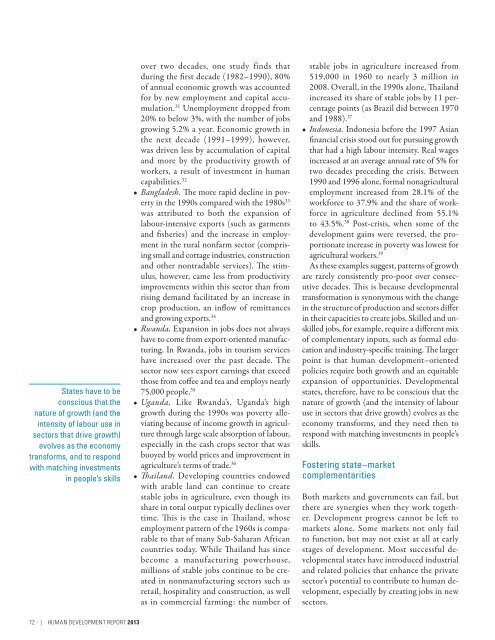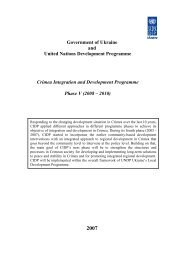E N S W - United Nations Development Programme
E N S W - United Nations Development Programme
E N S W - United Nations Development Programme
You also want an ePaper? Increase the reach of your titles
YUMPU automatically turns print PDFs into web optimized ePapers that Google loves.
states have to be<br />
conscious that the<br />
nature of growth (and the<br />
intensity of labour use in<br />
sectors that drive growth)<br />
evolves as the economy<br />
transforms, and to respond<br />
with matching investments<br />
in people’s skills<br />
over two decades, one study finds that<br />
during the first decade (1982–1990), 80%<br />
of annual economic growth was accounted<br />
for by new employment and capital accumulation.<br />
31 Unemployment dropped from<br />
20% to below 3%, with the number of jobs<br />
growing 5.2% a year. Economic growth in<br />
the next decade (1991–1999), however,<br />
was driven less by accumulation of capital<br />
and more by the productivity growth of<br />
workers, a result of investment in human<br />
capabilities. 32<br />
• Bangladesh. The more rapid decline in poverty<br />
in the 1990s compared with the 1980s 33<br />
was attributed to both the expansion of<br />
labour- intensive exports (such as garments<br />
and fisheries) and the increase in employment<br />
in the rural nonfarm sector (comprising<br />
small and cottage industries, construction<br />
and other nontradable services). The stimulus,<br />
however, came less from productivity<br />
improvements within this sector than from<br />
rising demand facilitated by an increase in<br />
crop production, an inflow of remittances<br />
and growing exports. 34<br />
• Rwanda. Expansion in jobs does not always<br />
have to come from export-oriented manufacturing.<br />
In Rwanda, jobs in tourism services<br />
have increased over the past decade. The<br />
sector now sees export earnings that exceed<br />
those from coffee and tea and employs nearly<br />
75,000 people. 35<br />
• Uganda. Like Rwanda’s, Uganda’s high<br />
growth during the 1990s was poverty alleviating<br />
because of income growth in agriculture<br />
through large scale absorption of labour,<br />
especially in the cash crops sector that was<br />
buoyed by world prices and improvement in<br />
agriculture’s terms of trade. 36<br />
• Thailand. Developing countries endowed<br />
with arable land can continue to create<br />
stable jobs in agriculture, even though its<br />
share in total output typically declines over<br />
time. This is the case in Thailand, whose<br />
employment pattern of the 1960s is comparable<br />
to that of many Sub-Saharan African<br />
countries today. While Thailand has since<br />
become a manufacturing powerhouse,<br />
millions of stable jobs continue to be created<br />
in nonmanufacturing sectors such as<br />
retail, hospitality and construction, as well<br />
as in commercial farming: the number of<br />
stable jobs in agriculture increased from<br />
519,000 in 1960 to nearly 3 million in<br />
2008. Overall, in the 1990s alone, Thailand<br />
increased its share of stable jobs by 11 percentage<br />
points (as Brazil did between 1970<br />
and 1988). 37<br />
• Indonesia. Indonesia before the 1997 Asian<br />
financial crisis stood out for pursuing growth<br />
that had a high labour intensity. Real wages<br />
increased at an average annual rate of 5% for<br />
two decades preceding the crisis. Between<br />
1990 and 1996 alone, formal nonagricultural<br />
employment increased from 28.1% of the<br />
workforce to 37.9% and the share of workforce<br />
in agriculture declined from 55.1%<br />
to 43.5%. 38 Post-crisis, when some of the<br />
development gains were reversed, the proportionate<br />
increase in poverty was lowest for<br />
agricultural workers. 39<br />
As these examples suggest, patterns of growth<br />
are rarely consistently pro-poor over consecutive<br />
decades. This is because developmental<br />
transformation is synonymous with the change<br />
in the structure of production and sectors differ<br />
in their capacities to create jobs. Skilled and unskilled<br />
jobs, for example, require a different mix<br />
of complementary inputs, such as formal education<br />
and industry-specific training. The larger<br />
point is that human development–oriented<br />
policies require both growth and an equitable<br />
expansion of opportunities. <strong>Development</strong>al<br />
states, therefore, have to be conscious that the<br />
nature of growth (and the intensity of labour<br />
use in sectors that drive growth) evolves as the<br />
economy transforms, and they need then to<br />
respond with matching investments in people’s<br />
skills.<br />
Fostering state–market<br />
complementarities<br />
Both markets and governments can fail, but<br />
there are synergies when they work together.<br />
<strong>Development</strong> progress cannot be left to<br />
markets alone. Some markets not only fail<br />
to function, but may not exist at all at early<br />
stages of development. Most successful developmental<br />
states have introduced industrial<br />
and related policies that enhance the private<br />
sector’s potential to contribute to human development,<br />
especially by creating jobs in new<br />
sectors.<br />
72 | HUMAN DevELOPMENT REPORT 2013
















